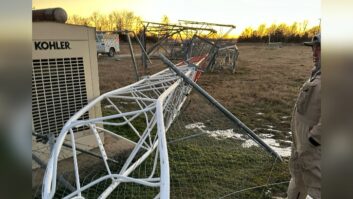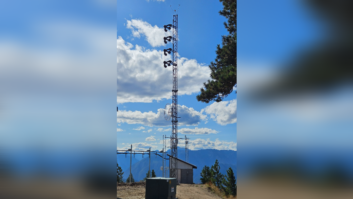Tower Lease Renegotiation
Apr 1, 2014 8:25 AM, By Kevin McNamara
Leasing space on your tower is a great option for generating additional revenue; however, many tower owners have received letters from tenants stating that their lease must be renegotiated or they will remove their equipment – either terminating or not renewing the lease. If you haven’t received one of these notices, it will be a matter of time before you do. Carriers are looking for new and creative ways to save money. One of their most aggressive initiatives is to renegotiate leases at a much lower rate than the initial value. In many cases, they are also seeking additional space on the ground and on the tower, as well as the ability to have blanket permissions to make changes as needed. Most of these letters are designed to instill fear of losing the revenue stream and sadly many people agree to the new, less profitable terms, when in fact there may be no reason to accept them.
It costs them money to leave
The first thing to know is that it costs carriers about $200k to develop a typical collocation site, not including equipment. Here are a few other considerations:
� Along with that expense, they brought some infrastructure into that site, including power and fiber (typically) lines. In many cases there were costs associated with structural reinforcement of the tower.
� Many municipalities require a zoning process for antennas collocated on an existing structure (typically a use variance of some type), which takes time and money to gain approvals. Removal of the equipment would void the approval.
� The network may require significant redesign to move the location of any site.
� There is an added cost to decommission a site.
As you can see, from a carrier’s perspective, they are not compelled to just pull down the site and leave.
But they may have a good reason
On the flip side of this, there is an ongoing effort to consolidate sites where feasible. This is particularly true where carriers have merged (i.e. Cingular/AT&T and soon, T-Mobile/Sprint, etc.). In terms of getting to an acceptable “economy of scale” there are benefits to decommissioning certain sites, particularly where one or the other carrier owns their tower and it is a simple matter to migrate them to it.
The end-game for carriers who are merging with other carrier is, to some degree, to increase subscriber base; but to a larger degree, it is about having more spectrum. The growth of smartphones is putting high demands on the networks due to people using more data. It is critical to have additional spectrum to support the current 4G and emerging technologies. Current technology allows base stations to consolidate the spectrum from multiple carriers into a single system. In fact, the “base” station may no longer be located at the base. More about that later. Yes, there could be a legitimate reason the carrier is going to want to pull out.
How do you deal with this?
In my opinion, the best way is to have as much information as possible in order to understand what options a carrier might have if they leave. Here are a few points to consider:
� Is the location of your tower in a high traffic area? If the tower is located near a busy street, intersection or highway, the site is probably carrying a lot of traffic. A carrier would be less likely to disturb it.
� Are zoning regulations restrictive for locating new or adding to existing structures in the immediate area? If so, you’re probably fine, otherwise they might be compelled to move or consolidate to another site.
� Are there a lot of towers in the area? Just because there is a tower doesn’t mean it is useable. You should find out if there is sufficient (or permitted) ground space to locate equipment. It’s not unusual for some older tower sites to be unusable due to a lack of space to locate ground equipment.
� Are the other towers structurally useable? With the change to the 222G guidelines, many older towers are no longer feasible, due to undersized foundations or steel. The major portions of 222G are also incorporated into the most current building codes, and therefore would require significant structural modifications to be useable for the addition of new equipment.
� Are you near any historical areas? There are particular restrictions to construct new structures/or to add equipment to existing structures that might cause some visual impact to registered historical areas, national parks and other areas. If a carrier is already on an existing structure that was grandfathered prior to many of the current environmental regulations, they are most likely going to stay put.
– continued on page 2
Tower Lease Renegotiation
Apr 1, 2014 8:25 AM, By Kevin McNamara
So what’s in the letter?
There are a few companies out there that work directly with carriers, they make money based on the savings they bring the carrier. The biggest players in this space are MD7 and Blackdot, although there are a few others.
The letter generally begins like this:
“‘Wireless carriers’ are changing how they operate due to a variety of factors, including heightened competition in the industry, changing customer needs and the bigger role Internet access is taking. In the past, emphasis was placed on rapidly building out networks in order to improve coverage. Today, the industry is shifting its focus in order to increase operational efficiency and to maximize the value of each cellular site.”
Here’s where it gets good
“As a result, ‘Carrier’ is re-evaluating and redesigning its network in order to reduce expenses and streamline operations. These changes will take into account the shifting network requirements, operational redundancies, and overlapping sites throughout the network.”
Then, not only do they want to reduce your rent, they want more control over the site.
“In order for your cell site to remain technologically viable for the network long-term, ‘Carrier’ will also require the addition of expansion language, basically in the form of the following:
“1. Expansion of Permitted Use: Allows ‘Carrier’ the ability to modify, supplement, upgrade, replace, expand or refurbish their equipment within the existing Premises.
“2. Expansion of the Premises: Allows ‘Carrier’ to expand the current Premises, on a space available basis, not to exceed an area equal to the current square footage of the Premises, at the current rate per square foot up to $1.50.”
What they are looking for here is the ability to make changes to the equipment. The new generation of radio equipment is a major departure from the big bulky ground mounted base stations that you see at the base of a cell tower. The new radio equipment is actually tower-mounted. The radio systems consists of multiple tower-mounted cabinets that house the radio system. The cabinets are typically mounted in the vicinity of each antenna. Keep in mind that each radio weighs about 70 pounds and there could be three or more. Instead of coaxial cables running up the tower, they use a hybrid cable that contains both the power and fiber connections. These radios can add a significant amount of load to some towers.
Here’s what they want to offer
“‘Carrier values its affiliation with you and would like to continue a long and mutually beneficial relationship for years to come based on one of the renewal options above.”
What they will offer you will vary, but likely will be one of these:
� Increase the term of commitment to 15 years (typically initial 5-year with 2-5 year renewals). They might offer a guarantee of 5 years max.
� Same as above, but with a 3-year guarantee.
� Long-term buyout of lease (i.e. give the owner a one-time lump sum at a greatly reduced rent).
� In all cases the rental amount and yearly percentage of increase are reduced significantly.
You can consider the first two options short term leases (5- or 3-year), because they will reserve the right to renegotiate again after that. The buy-out option may cause you to give up some control over your future plans (i.e. may have a significant impact to the value of a tower you want to sell in the future).
If you are approached to renegotiate your tower lease, do your homework and never accept the first offer, everything is negotiable.
McNamara is president of Applied Wireless, Cape Coral, FL.
April 2014
Update on transmitters, a new production vehicle for the Motor Racing Network, studio furniture, new products at the 2014 NAB Show and more….












